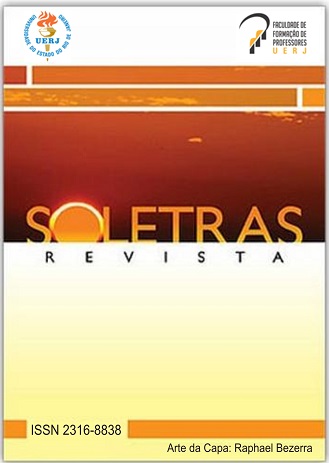Found footage and the gothic conventions
DOI:
https://doi.org/10.12957/soletras.2014.11121Palabras clave:
Literatura gótica, reivindicação da veracidade, filmes de horror, found footageResumen
Social, historical, political and economic changes somehow are invariably reflected in the cultural and artistic manifestations of their time. In Gothic literature this is noticeable in elements such as medieval settings when they were more frequent (The Castle of Otranto), or the questionings regarding the creationist thought suggested in Frankenstein, materialized in The Origin of Species and revisited in The Strange Case of Dr. Jekyll and Mr. Hyde and Dracula, works that also display the technicism and scientific advancements in the second phase of the Industrial Revolution. Nonetheless, one recurrent element in the literary Gothic convention regardless of its time is the claims to truthfulness, understood here as an effort to convince the reader/viewer that the story told indeed happened, as incredible as it seems. Therefore, this article verifies the ways in which the claims to truthfulness appear in found footage movies, observing how the classical Gothic characteristics are replicated or subverted in this subgenre of horror movies. The conclusion points out that convincing the reader/viewer that the story is real still is a priority in the Gothic agenda. The theoretical support comes from texts present in seminal companions to the Gothic (Hogle, 2002; Punter, 2006; Botting, 2004), from Jenkins (2009), through the notion of convergence culture, from Baudrillard (2002), through the notion of the three postmodern phantasies, and from Aufdenheide (2007), through the concept of claims to truthfulness.Descargas
Publicado
Número
Sección
Licencia
La aprobación de los artículos implica la concesión inmediata y sin coste de los derechos de publicación en esta revista. Los autores autorizan al Programa de Posgrado en Letras y Lingüística (PPLIN) a reproducirlos y publicarlos en la revista SOLETRAS, comprendiendo los términos “reproducción” y “publicación” según la definición del artículo 5º de la ley 9610/98. Los autores seguirán teniendo los derechos de autor en publicaciones posteriores.Se podrá acceder al artículo a través de la red mundial de ordenadores(http://www.e-publicacoes.uerj.br/index.php/soletras), siendo permitidas, a título gratuito, la consulta y la reproducción del ejemplar del artículo para elpropio uso del interesado.Casos de plagio o de cualquier ilegalidad en los textos presentados son responsabilidad exclusiva de sus autores.



